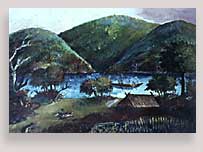Territorial Timeline

Protestant mission established at Tshimakain, now located in Eastern Washington
Reverend Cushing Eels, Reverend Elkanah Walker and their wives arrived in the Pacific Northwest in 1838 in response to William Gray’s call for more Protestant missionaries. Gray previously helped Marcus Whitman and H. A. Spaulding start their mission in 1836 and returned east for more reinforcements.
Soon after their arrival, Eels and Walker began establishing themselves among the Spokane Indians in the neighborhood of Fort Colville. After consulting with Archibald McDonald, the Hudson’s Bay Company representative at Fort Colville, they located their mission at a place called Tshimakain, (the place of springs) now called Walker’s Prairie, located about six miles north of the Spokane River on the trail linking Fort Walla Walla and Fort Colville.
The missionaries built churches, schoolhouses and mills. They taught Indians how to read, pray and farm. Tshimakain was a modest success and used by the Indians as a place to gather and trade. While at Tshimakain, Reverend Walker mastered the language of the Spokane Indians and prepared a primer in their language, the only publication in that language. The missionaries’ presence at Tshimakain ended in 1847 with the Whitman massacre. After the Indians killed the Whitmans and twelve others, missions in eastern Washington were evacuated. In January the women and children of Tshimakain were sent to Fort Colville, followed later by the missionaries. By the summer of 1848 Tshimakain was abandoned.
After the Whitman Massacre, Walker and his wife moved to the Willamette Valley where they continued their religious work for another thirty years. Reverend Eels and his wife moved to Walla Walla where Eels devoted his time to educational work. He became superintendent of schools for Whitman County and later founded Whitman College.